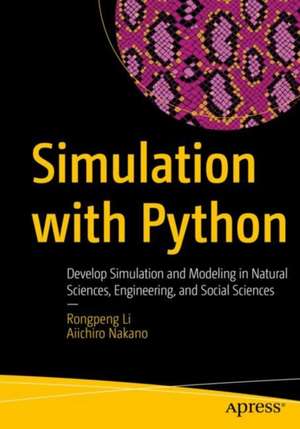Simulation with Python: Develop Simulation and Modeling in Natural Sciences, Engineering, and Social Sciences
Autor Rongpeng Li, Aiichiro Nakanoen Limba Engleză Paperback – 24 aug 2022
The book discusses simulation used in the natural and social sciences and with simulations taken from the top algorithms used in the industry today. The authors use an engaging approach that mixes mathematics and programming experiments with beginning-intermediate level Python code to create an immersive learning experience that is cohesive and integrated.
After reading this book, you will have an understanding of simulation used in natural sciences, engineering, and social sciences using Python.
What You'll Learn
- Use Python and numerical computation to demonstrate the power of simulation
- Choose a paradigm to run a simulation
- Draw statistical insights from numerical experiments
- Know how simulation is used to solve real-world problems
Who This Book Is For
Entry-level to mid-level Python developers from various backgrounds, including backend developers, academic research programmers, data scientists, and machine learning engineers. The book is also useful to high school students and college undergraduates and graduates with STEM backgrounds.
Preț: 254.34 lei
Preț vechi: 317.93 lei
-20% Nou
Puncte Express: 382
Preț estimativ în valută:
48.67€ • 50.53$ • 40.59£
48.67€ • 50.53$ • 40.59£
Carte disponibilă
Livrare economică 03-17 martie
Livrare express 14-20 februarie pentru 109.18 lei
Preluare comenzi: 021 569.72.76
Specificații
ISBN-13: 9781484281840
ISBN-10: 1484281845
Pagini: 166
Ilustrații: XV, 166 p. 90 illus., 80 illus. in color.
Dimensiuni: 178 x 254 x 24 mm
Greutate: 0.33 kg
Ediția:1st ed.
Editura: Apress
Colecția Apress
Locul publicării:Berkeley, CA, United States
ISBN-10: 1484281845
Pagini: 166
Ilustrații: XV, 166 p. 90 illus., 80 illus. in color.
Dimensiuni: 178 x 254 x 24 mm
Greutate: 0.33 kg
Ediția:1st ed.
Editura: Apress
Colecția Apress
Locul publicării:Berkeley, CA, United States
Cuprins
Chapter 1: Calculating Pi and Beyond: Searching Order in Disorder with Simulation.- Chapter 2: Markov Chain: A Peek into the Future.Chapter 3: Multi-Armed Bandits: Probability Simulation and Bayesian Statistics.- Chapter 4: Balls in 2D Box: A Simplest Physics Engine.- Chapter 5: Percolation: Threshold and Phase Change.- Chapter 6: Queuing System: How Stock Trades are Made.- Chapter 7: Rock, Scissor and Paper: Multi-Agent Simulation.- Chapter 8: Matthew Effect and Tax Policy: Why the Rich Keeps Getting Richer.- Chapter 9: Misinformation Spreading: Simulation on a Graph (Centrality, Networkx).- Chapter 10: Simulated Annealing and Genetic Algorithm.
Notă biografică
Ron Li is a long-term and enthusiastic educator. He has been a researcher, data science instructor, and business intelligence engineer. Ron published a highly rated (4.5-star rating out of 5 on amazon) book titled Essential Statistics for Non-STEM Data Analysts. He has also authored/co-authored academic papers, taught (pro bono) data science to non-STEM professionals, and gives talks at conferences such as PyData.
Aiichiro Nakano is a Professor of Computer Science with joint appointments in Physics & Astronomy, Chemical Engineering & Materials Science, Biological Sciences, and at the Collaboratory for Advanced Computing and Simulations at the University of Southern California. He received a PhD in physics from the University of Tokyo, Japan, in 1989. He has authored more than 360 refereed articles in the areas of scalable scientific algorithms, massive data visualization and analysis, and computational materials science.
Textul de pe ultima copertă
Understand the theory and implementation of simulation. This book covers simulation topics from a scenario-driven approach using Python and rich visualizations and tabulations.
The book discusses simulation used in the natural and social sciences and with simulations taken from the top algorithms used in the industry today. The authors use an engaging approach that mixes mathematics and programming experiments with beginning-intermediate level Python code to create an immersive learning experience that is cohesive and integrated.
After reading this book, you will have an understanding of simulation used in natural sciences, engineering, and social sciences using Python.
You will:
- Use Python and numerical computation to demonstrate the power of simulation
- Choose a paradigm to run a simulation
- Draw statistical insights from numerical experiments
- Know how simulation is used to solve real-world problems
Caracteristici
Explains mathematics, statistics, network theory, queuing theory, and Monte Carlo simulation, etc. Covers simulation in natural sciences, engineering, and social sciences Includes simulations selected from the top algorithms used in the industry today
